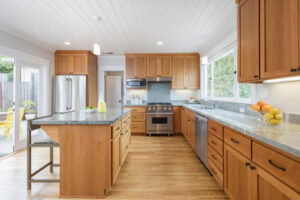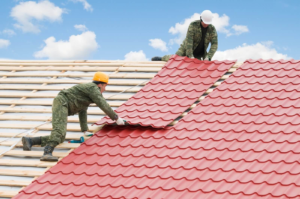Kitchen Remodeling Warrington PA involves changing the look of your kitchen space. This may include adding or removing walls, expanding storage space and rearranging appliances and fixtures.

Trends come and go, but a timeless design can stand the test of time. Choose finishes and materials that will look good for years to come.
The kitchen is the heart of the home, and as such, it needs to be both visually appealing and functional. Striking the right balance ensures that your kitchen is a space you enjoy spending time in and that it caters to all your kitchen’s essential functions. A kitchen that is both aesthetically pleasing and functional is a kitchen designed to last.
Kitchen remodeling focuses on aesthetic upgrades that enhance the look of your kitchen and create a stylishly inviting environment. It can include anything from new lighting fixtures to a fresh coat of paint, and incorporating the right details can make a big difference in your overall kitchen design.
Modern kitchen designs prioritize minimalist design principles and feature sleek surfaces that look streamlined and uncluttered. Features like handle-less cabinetry and hidden storage solutions contribute to the contemporary look, while adding practicality to your kitchen. Neutral color schemes accentuate the streamlined design, and pops of bold accent colors can be used as focal points in the kitchen to add personality.
Wood accents, whether in the form of countertops, floors or shelves, lend a natural, organic look to the kitchen that is both warm and timeless. Light wood tones complement modern designs, while darker hues work well with traditional styles. Adding natural elements to your kitchen also contributes durability and longevity, which is an important consideration when it comes to kitchen remodels.
The type of countertop and backsplash you choose will have a significant impact on your kitchen’s overall style. For example, quartz countertops offer durability and come in a variety of colors that can match any décor. Marble and granite are also popular options, providing a high-end look that is both luxurious and durable.
Decorative lighting adds visual interest and sets the mood in your kitchen, while task lighting can help you get tasks done more efficiently. Pendant lights over the island and recessed lighting under cabinets are both great choices for creating dramatic effects and adding warmth to your kitchen.
Before making any changes to your kitchen layout, it is a good idea to do a test run and cook in the space as you normally would so that you can identify any potential issues or areas for improvement. Kitchen experts can assist you in designing a layout that combines both function and style to create a kitchen that is a joy to cook in.
Functionality
A well-designed kitchen should not only be beautiful, but it must also function efficiently. The space should be easy to navigate and accommodate the family’s needs. Incorporating a spacious island, plenty of storage space and easy-to-clean surfaces will improve the workflow and overall functionality of the kitchen.
Before diving into the specific design elements of your new kitchen, determine how you will use it. Discuss your lifestyle with family members and make note of any areas that may need improvement. For example, do you plan to entertain often? If so, you may want to add a wine or coffee bar. Or, will you be cooking for a large group of people? This will impact the layout and size of appliances, work aisles, cabinet placement, etc.
Another important consideration is your budget. Establishing a clear, realistic budget will guide all other decisions throughout the process and help you avoid overspending. It is also helpful to visit kitchen showrooms and home renovation stores to observe layouts, designs and products firsthand and get a feel for your desired style. You can also find ideas online or in magazines, but remember that not all products are available locally and some have long lead times.
Choosing the right countertops and backsplashes is vital to the overall look of your kitchen. Be sure to consider durability and maintenance requirements as well. For example, quartz countertops are low-maintenance and highly durable, while granite offers a more luxurious look but requires regular care to keep it looking like new.
Kitchen remodeling is a great way to upgrade your home and increase its value, especially in a competitive market. Prospective buyers often prioritize updated kitchens when deciding on homes for purchase. By working with professional kitchen remodelers, you can design the ideal kitchen for your family and enjoy a higher return on your investment when you eventually sell your home.
Energy Efficiency
The kitchen is one of the most-used rooms in the house. It’s where we prepare meals, chat with family over after-school snacks, and entertain guests during holidays. But this busy hub also uses a lot of energy — to light, heat, cool, and run appliances. That’s why it’s important to take a holistic approach to kitchen remodeling. By choosing eco-friendly materials and techniques, you can make your home more energy efficient without sacrificing style.
The goal of kitchen remodel is to create a space that fits your lifestyle and preferences. But how do you define “remodel” versus “renovation?” There are distinct differences between the two, with remodeling offering more extensive structural changes and luxury upgrades. For homeowners who want to enhance the functionality and aesthetics of their kitchen, renovation is a more cost-effective option that still makes noticeable improvements.
To make your kitchen more energy efficient, start by replacing your old appliances with newer models. Look for those with the Energy Star label, which indicates superior efficiency. From refrigerators to dishwashers, upgrading to energy-efficient models can reduce your electricity bills while lowering your carbon footprint.
Another way to save on energy is through improved lighting and ventilation. Consider installing LED lights and dimmer switches that can control the amount of brightness in your kitchen. These bulbs use up to 75% less energy than incandescents and last twice as long. Additionally, install ENERGY STAR-certified fixtures that can help reduce water usage and heating costs.
When it comes to ventilation, enlarge your windows and add skylights to let natural light flood your kitchen and cut down on energy usage. Also, replace your old single-pane windows with ENERGY STAR-certified ones to eliminate drafts and condensation.
Adding energy-efficient features to your kitchen can increase its resale value and attract eco-conscious buyers. This is especially true if you choose to include solar panels in your kitchen. While they are more expensive than other options, they provide a renewable energy source that can significantly reduce your utility bills and emissions. In addition, you may be eligible for tax credits and rebates, depending on your location and government incentives.
Value
One of the most popular reasons homeowners decide to remodel their kitchens is to increase the home’s resale value. In general, kitchen remodels are considered some of the best investments you can make in your home, and they often recoup a good chunk of their cost during resale. However, it’s important to keep in mind that you won’t necessarily recoup all of your investment, and how much you actually get back depends on the scope of your project and how well it was executed.
The most common type of kitchen remodeling is a minor renovation, which includes changes like painting cabinets, replacing appliances, and adding a backsplash. These projects are relatively affordable and can usually be completed on a budget of $10,000 or less. Major kitchen remodels, on the other hand, typically involve a significant change to the structural integrity of the kitchen and are more expensive. This may include opening walls, changing electrical and plumbing systems, and relocating appliances. While a major renovation can add great value to your home, it’s important to carefully consider your needs and budget before making any big changes.
Kitchen remodels that incorporate high-end materials and features are more likely to increase resale value. These upgrades are generally more durable, look better, and will appeal to a wide range of potential buyers. Choosing a timeless design style is also a wise choice, as it will be more appealing to future owners and will stand the test of time.
Another way to boost resale value is to install energy-efficient appliances and fixtures. This can help to reduce your utility bills and save you money in the long run. It’s also a good idea to install a smart thermostat that can automatically adjust your heating and cooling, as this will help to keep your home at a comfortable temperature while saving you money on your energy bill.
The key to maximizing your home’s value is to be strategic about your kitchen remodel and choose upgrades that will appeal to the majority of buyers. A kitchen that’s designed around the latest trends may not be as attractive to a broad range of people and could end up deterring potential buyers from your home.


